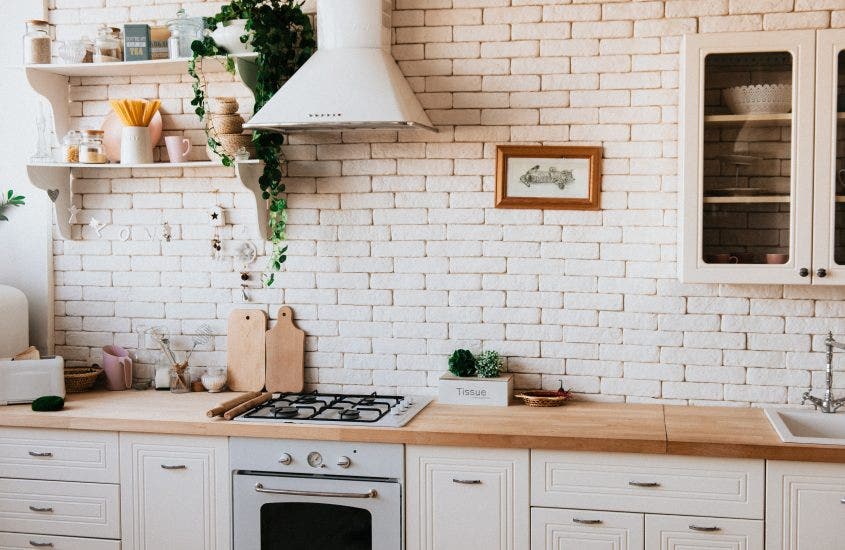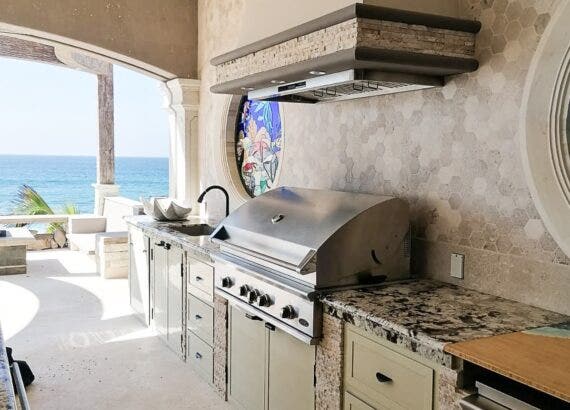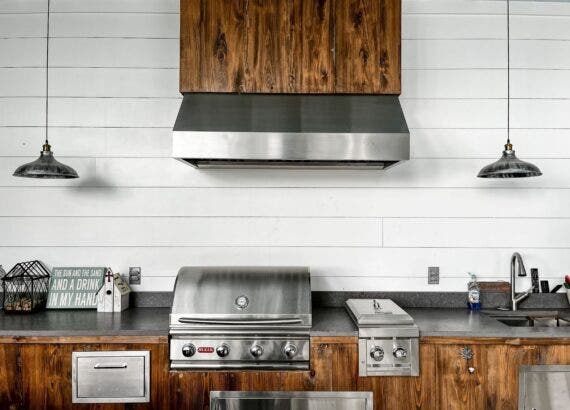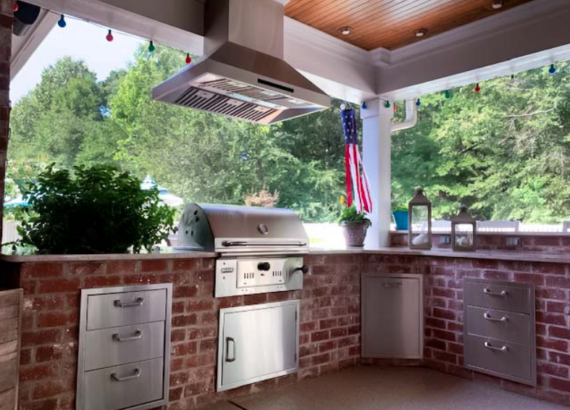What is Farmhouse Design, Anyway?

Farmhouse design in America is derived from early settlers moving west of the Mississippi and beyond. It comes from the unique buildings that were often times next to house barns, which were used to house cattle, grain, corn, and other farm products.
For practicality purposes, most farmhouses had a rectangular floor plan and a fireplace in the middle used for both heating the house and cooking. Now that we know the history, let’s get into the basics of farmhouse design!
Classic farmhouse design relies heavily on wooden features, particularly unfinished or rough looking wood. Wood furniture, wood chairs, wood decorations, and more. Other accent features included metal furnishings, such as iron lighting fixtures and metal bar stools with wooden seats.
Neutral color palettes are frequently used in farmhouse design, most times following the 60-30-10 rule. This color scheme allows for a very homey feel in any room of the house.
Table of Contents
The 60-30-10 Rule
First, let’s get the color scheme down pat. Most interior design follows the 60-30-10 rule and farmhouse design is no exception to the rule.
So, what exactly is the 60-30-10 rule? Essentially, 60 percent of the room is one neutral color, such as white, tan, light gray, or cream. This is your base color and should cover the majority of your room, including walls, rugs, couches, and other large lounge furniture.
It sets the tone for the rest of the colors in the room to come, but shouldn’t be out to make a statement. As seen in the picture above, the majority of the room is white, covering roughly 60 percent of the room.
Next, 30 percent of the room is slightly bolder colors, and, for farmhouse design, include earthy tones such as forest greens, deep browns, darker tans, and even some yellows. These colors are less abundant than your main color, but can cover parts like painted furniture, large picture frames or paintings, drapes or curtains and smaller pieces of lounge furniture, like armchairs.
In the picture below, tan takes up around 30 percent of the room in the form of the bed cover, door, desk, and other decorative items.
Finally, ten percent is withheld for accent colors. These should be the boldest colors in the room, such as reds, oranges, bright blues (or navy blues!) – even deep purples in some cases.
Accents in rooms include throw pillows, blankets, picture frames, pots for plants and any sort of artwork, including photographs. Blue is accented in the above picture, coming out in the rug underneath the bed!
Most farmhouse design follows this rule, but exceptions can be made. You can pick multiple accents colors as long as they are adjacent to each other or directly across from each other on the color wheel.
For example, orange and yellow and orange and blue will go together, but orange and purple will contrast each other. There can also be modifications to the 60-30-10 rule. For example, an idea could be 60-15-15-10, and the colors picked are white, tan, orange, and blue.
Farmhouse Style Furniture
Most farmhouse style furniture is wood based, especially game tables, side tables, bookcases, and television units/cabinets. Bookcases can flank television cabinets with barn doors to make for a hidden TV, adding a deeper feel to the furniture of a living room or family room.
Bookcases and other shelving units can be used around other areas of this room and a playroom, if needed. For lounge units, leather is seldom used, opting instead for softer fabric that matches the main color of the room.
Open shelving is common in farmhouse bathrooms and is particularly effective in smaller bathrooms. They will help the bathroom feel bigger and come with storage space on the shelves with the added bonus of a “bigger” bathroom.
In bathrooms and the kitchen, below the sink storage (or island storage in kitchens!) can include a combination of closed and open shelving units to further the openness feel in smaller rooms.
Open shelving in kitchens and family rooms are often used to hold decorative pieces that are also functionally sound. Think of dinner plates and mugs on kitchen shelves or blankets and books on family room shelves.
Industrial Farmhouse Design
Light fixtures and ceiling fans include some industrial accents to certain rooms. Farmhouse kitchens and family rooms decorated with hanging iron light fixtures bring a room alive. The more vintage, the better!
Lots of these items can be hand-me-downs from older generations. There’s nothing like a piece from great-grandma’s old house sitting in your new 2020 farmhouse kitchen. These can be simple things, such as cutting boards, old wagon wheels, apple-picking ladders, and rustic metal storage bins. Wicker storage boxes can also house books, blankets, toys, and more!
The main goal here is to make sure these pieces don’t look brand new. That’s not to say you should look for pieces that are falling apart. But, if a piece at a thrift store looks weathered but structurally sound, that may be the piece for you!
Make sure these pieces function well and can collect the clutter of a room. A strewn blanket across a couch may add some aesthetic, but not four blankets! Instead, put those in a wicker basket or hang them on an apple-picking ladder!
Modern Farmhouse Design
Most modern design combines sharp lines, smooth edges, and minimalism. Also, today’s modern kitchen appliances are primarily stainless steel, so add in elements of other metal in your design! This can be as simple as adding a metal “What’s on the Menu” sign in the kitchen, cast-iron pots, or small metal decorative pieces.
It’s nearly impossible to obtain a true farmhouse look with that Samsung fridge, but with a little thinking, it’s achievable.
Farmhouse Decor
Decor in farmhouse interior design thrives on practicality of the items. Are you sick of that word yet? Everything must be practical in farmhouse design because no space was wasted in the 1850s! However, there are some elements that can be purely decorative, but of course, they’re not replacing those practical items! Let’s dive into a couple of these.
Shelving Units
Shelving units will hold a whole host of items, and here, it’s up to you what goes on these shelves! Plants are a big plus here, whether fake or real! They give an outdoor feel to rooms and serve as a calming mechanism to most people.
Small plants will thrive in bathrooms, front rooms, and bedrooms. Save your larger plants for your larger rooms, such as kitchens, family rooms, offices, and the master bedroom. Now, these rooms in your house may vary in size, so make sure the plants are noticeable but don’t take up too much room!
Pictures
Photos, paintings, and graphic illustrations make rooms feel alive and will tell a story to any person that walks through the front door. Other decor items may be small and personal to your family and may include kids pottery work from art class, old dishes or items from grandma’s house, and glass bottles filled with sand and seashells.
The goal here is to make your house feel like a home. The more stories a certain item can tell, the more impact it’ll have on the room as a whole.
Extra Features to Include
Now that you’ve got the feel of farmhouse design, here’s some extra features you can include if you have the space to do so!
Barn doors to cover closets or television units in your bedroom add instant farmhouse flair to your room. If you can get an ‘x’ on the door as well, awesome! Wooden hat racks with metal hooks offer simple design and practicality to your front room or bedroom. As for an avid hat collector with 30+, this could be a very big addition to your house. Make it count!
Another big change could be unique shelving units. These can be wacky designs that hold small objects, or large units that hold a wall of ivy plants and books, among other things. This is where you get creative and personalize it to your family’s needs.
Other welcome features include chalkboards, large pictures or paintings, wooden wheels, and maybe another apple-picking ladder – this time in a different room! Perhaps your bathroom, bedroom, or front room could use some extra vintage furnishings.
Finally, hanging plants are a beautiful find. Apply where practical and necessary, and make sure to keep these out of jumping distance of dogs!
By now, we hope you’ve learned a lot about farmhouse design and are starting idea boards for how to convert some of your rooms in your house to the farmhouse style!
We have a farmhouse board on our Pinterest, so make sure you check it out! We have different sections too, including bathrooms, bedrooms, living rooms, and more! Browse all of our pins or go to a section that interests you!
My recommendation is to start with small rooms first. Bathrooms are the smallest rooms in the house and can often accommodate the farmhouse look very easily.
Start by replacing cabinetry with floating shelves and add in a plant or two! Don’t sacrifice storage space for looks, but instead work with what you can to start your farmhouse design project.
Happy decorating!
If you have found any of our blog content helpful in any way, please leave us a review on Yelp or Google. It only takes 10 seconds!







Comments are closed.